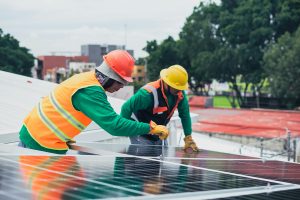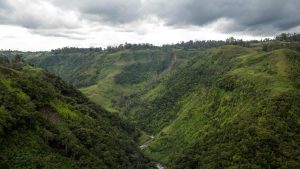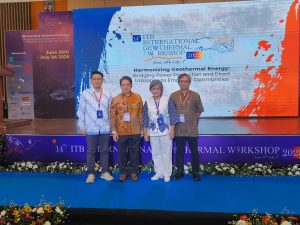by: Dani Kosasih
Ideally, after the issuance of the Tax Harmonisation Law that enacted the implementation of a carbon tax on 7 October 2021, the tax should be implemented six months later in April of this year. However, the government postponed the implementation of the carbon tax until July 2022. Through an official statement, the Ministry of Finance admits that they still need to draw up various technical rules for the implementation of this carbon tax.
Head of the Ministry of Finance Fiscal Policy Agency (BKF) Febrio Kacaribu, said that currently, the government is in the phase of preparing tariffs compilation and the basis for imposing, methods of calculating, collecting, paying or depositing, reporting, and a roadmap for the carbon tax.
Meanwhile, the Ministry of Energy and Mineral Resources (ESDM) will determine regulations on the upper emissions limit for the coal power plant (PLTU) sub-sector and the procedures for implementing the carbon economic value (carbon pricing) in power plants.
According to Kacaribu, from the implementation of the carbon tax, the government will not only get additional income for the state, but the implementation of the carbon tax will also become an instrument of climate control in achieving sustainable economic growth according to the “polluters pay” principle.
The implementation of the carbon tax does not only refer to the Tax Harmonisation Law. This tax instrument is also related to Presidential Regulation 98/2021 concerning the Implementation of Carbon Economic Values (carbon pricing) to Achieve Nationally Determined Contribution Targets, as well as control of greenhouse gases (GHG) emissions in national development. The Presidential Regulation regulates the economic value of carbon, one of which is related to the implementation of a carbon tax.
Carbon tax mechanism
The tax mechanism imposed will use a cap-and-trade scheme or a carbon emission restriction scheme and trade in emission permit certificates and emission limit schemes (cap-and-tax). The cap-and-trade scheme is a scheme that applies to entities that emit higher than the specified emission cap or limit, then are required to purchase an Emissions Permit Certificate (SIE) from the entity that emits below the cap or purchase an Emission Reduction Certificate (SPE/carbon offsets).
Meanwhile, the cap-and-tax scheme is a scheme to limit emissions and impose taxes if the issued emissions exceed the specified limit. This means, if the agency or entity is unable to purchase an SIE or SPE for emissions above the full cap, the remaining emissions that still exceed the cap will be subject to carbon tax.
In the early stages of implementation (2022 – 2024), the amount of the carbon tax rate has been set at IDR 30.00 per kilogram of carbon dioxide equivalent (CO2e). Coal PLTU Agency is the sector affected by the initial trial. When referring to Article 13 Paragraph (5) of the Tax Harmonisation Law, PLN has the potential to bear carbon taxes from two routes, namely, as a buyer of goods containing carbon (such as coal) and carrying out activities that produce carbon emissions.
Furthermore, in 2025, the carbon tax will be fully implemented along with the expansion of sectors subject to carbon tax taxation, which of course will be carried out in stages according to the readiness of the relevant sector, including the imposition of a carbon tax on individuals. The implementation of a carbon tax on individuals which is likely to be realised through an increase in fuel prices.
Too rushed
The Executive Director of the Institute for Essential Services Reform (IESR), Fabby Tumiwa, believes that the delay in implementing the carbon tax is the result of the government’s haste in deciding the tariff rate, so that in the end, the applied tariff is far below the global tariff.
He said the World Bank had recommended a carbon tax rate of around USD35-40 per tonne. In China, when the government wants to start an emissions trading scheme for power generation, they set a price of up to USD 6.9 per tonne and will increase to USD 15 per tonne by 2030. That is, a figure of IDR 30.00 per kilogram or a little more than the two US dollars per tonne imposed by the government is still too cheap.
“During this delay, the government should start to adjust the carbon price again with the emission reduction target in 2025 and 2030,” he told tanahair.net.
On the other hand, he said that the government must build clearer and more transparent lines of communication to the industry and business actors regarding the plan to implement the carbon pricing. Currently, it is undeniable that there have been some rejections from the industrial world in Indonesia. The reason can not be separated from the lack of information received from the government.
This information must be clear. Tumiwa said the government must be able to build clearer and more transparent lines of communication to the industry and business actors. Currently, it is undeniable that there have been some rejections from the industrial world in Indonesia. The reason can not be separated from the lack of information provided by the government. The purpose of this regulation is to reduce carbon emissions. This means that this regulation must be able to encourage the industrial or economic sector to transform towards lower emission development.
“Of course everyone has to sit together, be it the government, industry associations, industry players, Kadin and other stakeholders,” continued Tumiwa.
From the business world, the Director of PT Bumi Resources Tbk. (BUMI), Dileep Srivastava admits the fact that until the time this article was published, he still had not received comprehensive information regarding the carbon tax regulation. In fact, regarding carbon credits, in his understanding, Srivastava believes that carbon credits will not affect the GHG emission reduction plan.
A carbon credit itself is a tradable licence and allows companies to pollute to some extent, but that limit will be reduced periodically. Even in the Carbon Economic Value mechanism, it is explained that entities carrying out emission reduction activities can sell their carbon credits
to entities requiring carbon credits.
“This carbon credit is not a solution to reduce emissions. Carbon credits are only a mechanism in carbon trading,” explained Srivastava to tanahair.net.
Carbon tax roadmap
One of the reasons for the government delaying the implementation of the carbon tax is that the government still has to work out a roadmap for this carbon tax. Anih Sri Suryani, Associate Researcher for Environmental Policy at the Research Center of the Indonesian House of Representatives Expertise Board, in his study entitled “Preparation for Carbon Tax Implementation in Indonesia” explained that the content of the roadmap currently being prepared by the government contains several points such as: NDC, its priority sector targets, alignment with new and renewable energy (EBT) development and alignment with other policies. Later, the carbon tax will begin to be implemented in stages according to the road map that has been made.
In addition to being a priority in achieving the NDC target, the carbon tax roadmap must also consider the readiness of priority sectors and continue to prioritise the interests of the community. This roadmap must take into account the development of the carbon market and be synchronised with the carbon market roadmap, because Indonesia has a major market potential in the world’s carbon market.













